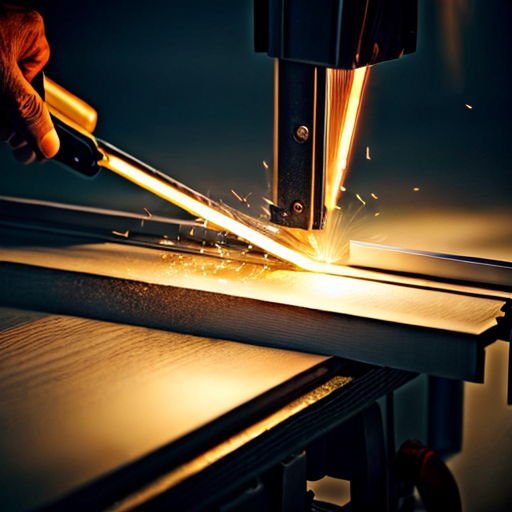Understanding Taper Cuts: A Comprehensive Guide to Table Saw Tapers is here to rescue you from the perplexing world of taper cuts. Picture this: you're standing in front of your table saw, scratching your head, wondering how on earth you're going to achieve that elegant, tapered look. Fear not, my fellow woodworkers! This guide will unravel the mysteries of taper cuts faster than you can say 'lumberjack.' With step-by-step instructions, handy tips, and a sprinkle of humor, you'll be cutting tapers like a pro in no time. So, grab your saw, put on your safety goggles, and let's embark on this adventure together. We promise, no 'Ah's involved!
An interesting fact about cutting a taper on a table saw is that it requires the use of a tapering jig. This jig is a simple yet ingenious device that holds the workpiece at an angle to the blade, allowing for precise and controlled taper cuts. The jig typically consists of a long, narrow board with a guide rail attached to it. By adjusting the position of the workpiece along the guide rail, different taper angles can be achieved. This method not only ensures accuracy but also enhances safety by keeping the workpiece stable and preventing kickback.
When it comes to tackling taper cuts on a table saw, having the right tools and safety precautions in place is essential. First things first, make sure you have a reliable table saw with a sharp blade and a sturdy fence. Safety goggles, ear protection, and a dust mask are your trusty sidekicks in this adventure. Remember, safety first, folks! Now, let's talk about the secret weapon for taper cuts – a tapering jig. This nifty tool will ensure precise and consistent results, saving you from any 'oops' moments. So, gear up, stay safe, and let's dive into the world of taper cuts with confidence and a touch of finesse.

Step-by-Step Guide: Cutting Tapers on a Table Saw with Precision and Accuracy
Cutting tapers on a table saw may seem like a daunting task, but fear not, my fellow woodworkers! With this step-by-step guide, you'll be able to achieve those sleek and stylish tapered cuts with precision and accuracy.
Step 1: Set Up Your Table Saw First things first, ensure that your table saw is set up properly. Make sure the blade is sharp and securely fastened. Adjust the height of the blade to the desired taper angle. It's crucial to have a sturdy fence in place to guide your workpiece.
Step 2: Measure and Mark Measure the length of the taper you want to cut on your workpiece. Using a pencil or a marking knife, mark the starting and ending points of the taper on both edges of the workpiece. This will serve as your guide throughout the cutting process.
Step 3: Set Up the Tapering Jig A tapering jig is a handy tool that will help you achieve consistent and accurate taper cuts. Attach the jig to the table saw's fence, ensuring it is securely in place. Adjust the angle of the jig to match the desired taper angle.
Step 4: Position the Workpiece Place your workpiece against the tapering jig, aligning the starting point of the taper with the blade. Make sure the workpiece is firmly pressed against the jig and the fence, providing stability and preventing any unwanted movement during the cut.
Step 5: Make the First Pass Turn on the table saw and slowly feed the workpiece into the blade. Maintain a steady and controlled pace, allowing the blade to cut through the wood smoothly. Keep your hands clear of the blade and use a push stick or push block to guide the workpiece through the cut.
Step 6: Repeat the Process Once the first pass is complete, move the workpiece slightly to the side, aligning the next mark with the blade. Repeat the process, making additional passes until you reach the end of the taper. Take your time and ensure each pass is consistent and accurate.
Step 7: Finishing Touches After completing the taper cuts, inspect the edges for any roughness or imperfections. Use sandpaper or a hand plane to smooth out any uneven surfaces, ensuring a clean and polished finish.
Remember, practice makes perfect! It's important to start with scrap wood or practice pieces before attempting tapers on your final project. Always prioritize safety by wearing protective gear, keeping your hands clear of the blade, and maintaining a focused mindset.
So, my fellow woodworkers, armed with this step-by-step guide, you're now equipped to tackle taper cuts on a table saw with precision and accuracy. Embrace the challenge, unleash your creativity, and let those tapers shine in all their tapered glory! Happy cutting!
Fun fact: Did you know that cutting a taper on a table saw can be achieved by using a technique called 'the wedgie method'? This method involves creating a custom wedge-shaped jig that is placed between the workpiece and the table saw fence. As the workpiece is pushed through the saw, the wedge gradually changes the angle, resulting in a perfectly tapered cut. It's like having a secret weapon for creating unique and stylish tapered pieces!
Mastering the art of taper cuts on a table saw opens up a world of possibilities for your woodworking projects. Once you've got the basics down, it's time to explore advanced techniques and tips to achieve those perfect taper cuts. One technique to consider is using a featherboard to hold your workpiece securely against the fence, minimizing any potential movement. Additionally, experimenting with different blade angles can create unique taper designs. Remember to take your time, make small adjustments, and always double-check your measurements before making the cut. With practice and a touch of creativity, you'll soon be creating flawless taper cuts that will leave your fellow woodworkers in awe.